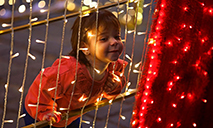Perseverance and tradition sewn into Bohai Mohe embroidery
Stitches with various colors are overlapped in four to eight layers, as an embroidery of Jingpo Lake and Diaoshuilou waterfall, so vivid and lifelike, let people at first glance mistake the artwork for photographic reproductions. Its creator, Jiang Lina, was meanwhile sitting behind a large wooden frame busy working to complete the last several stitches.
Inherited and passed on from generation to generation starting 1,300 years ago, Manchu Bohai Mohe embroidery, which is recognized as a national intangible cultural heritage, is an ethnic folk craft found in Mudanjiang City, in northeast China's Heilongjiang Province. The traditional embroidery techniques were developed by the Mohe people of the ancient Bohai Kingdom (698-926 CE). As an inheritor of Bohai Mohe embroidery, Jiang learned the embroidery techniques from Sun Yanling, whose family’s ancestors have continued this craft for more than 1,000 years.
The distinctiveness of Bohai Mohe embroidery lies in its silken material. It uses tussar silk, collected from tussar moths living in the wild in northeastern China. The silk is thick, coarse, and colorful.
The craft makes use of unique embroidering techniques: such as triangular stitching and "chicken claw" stitching. "By overlapping those stitches in four to eight layers, we can render more depth to the work," Jiang told People's Daily Online. "The embroidery has the characteristics of people in northern China, as we are quite bold and big-hearted, and it has been hailed as the ‘oil painting of embroidery’."
Interested in embroidery from a young age, Jiang regards herself as a calm and composed person who loves to busy herself creating something with her own hands.
Jiang and her teacher Sun spared no effort in promoting the art, and turned it into an industry. They now run a team of 1,300 experienced embroiderers who can complete embroidery tasks in flexible ways. For example, they can choose to work at home and have the finished embroidery delivered via courier. New technologies are also used to make training more accessible. Embroidery beginners can now use printed photos as a template. Apart from traditional embroidery decoration, they also embed embroidery elements into travel souvenirs, home decorations, and daily clothes, making more people familiar with the art form.
The devoted artists have now launched two embroidery museums, one in Mudanjiang and the other in Shenzhen in Guangdong Province. The art has also been promoted to the rest of the world via cultural exchange activities.
Jiang is training several apprentices now, hoping to train them to become future inheritors of the traditional craft. "All I want is to pass on my craftsmanship and the craftsman’s spirit," she said.
(Web editor: Zhang Wenjie, Liang Jun)










